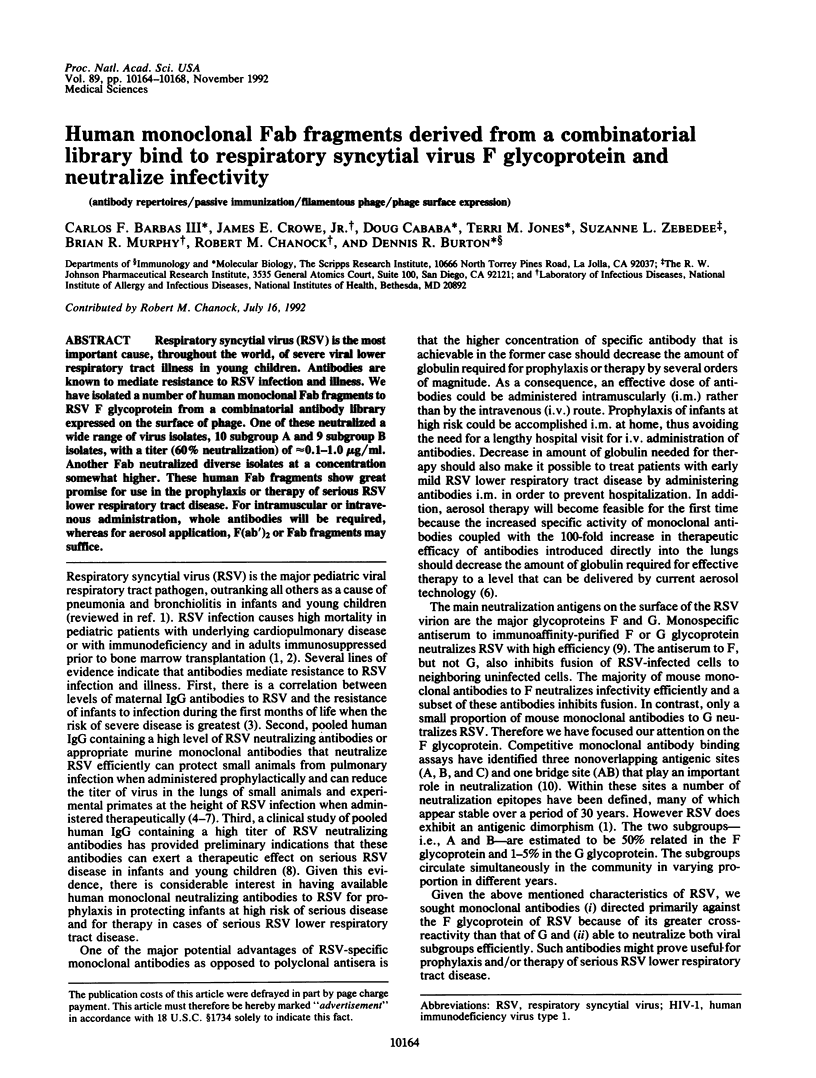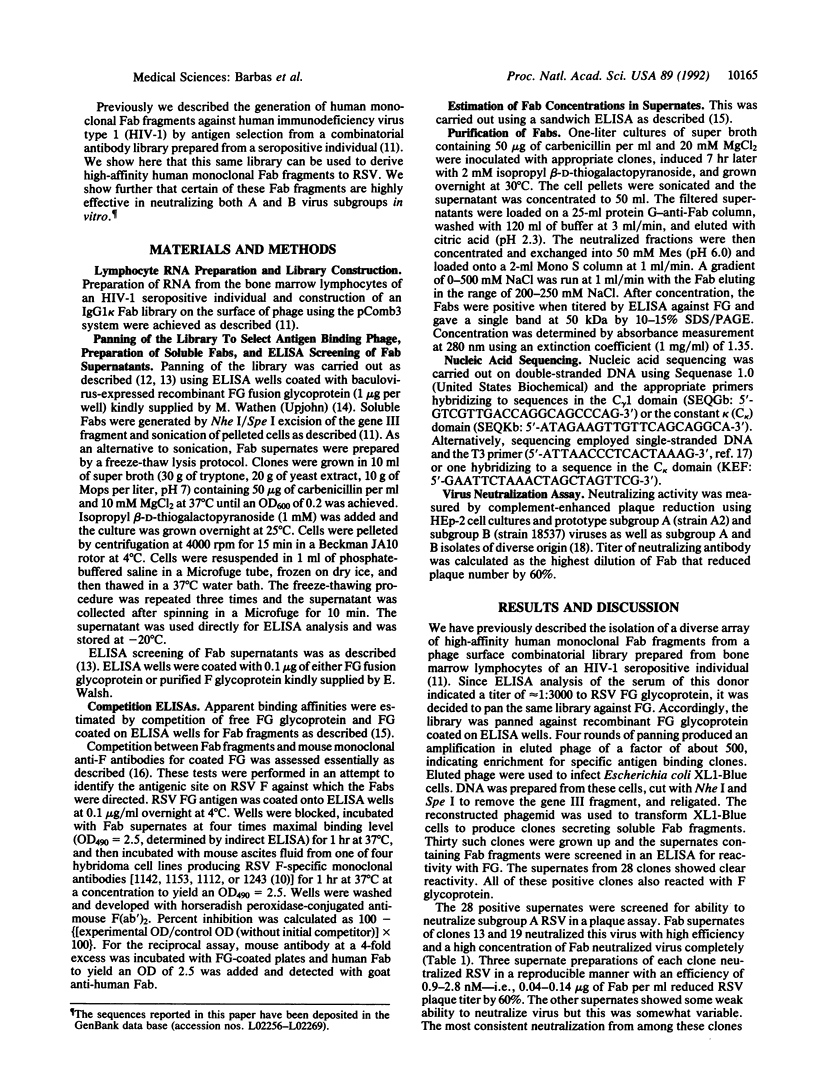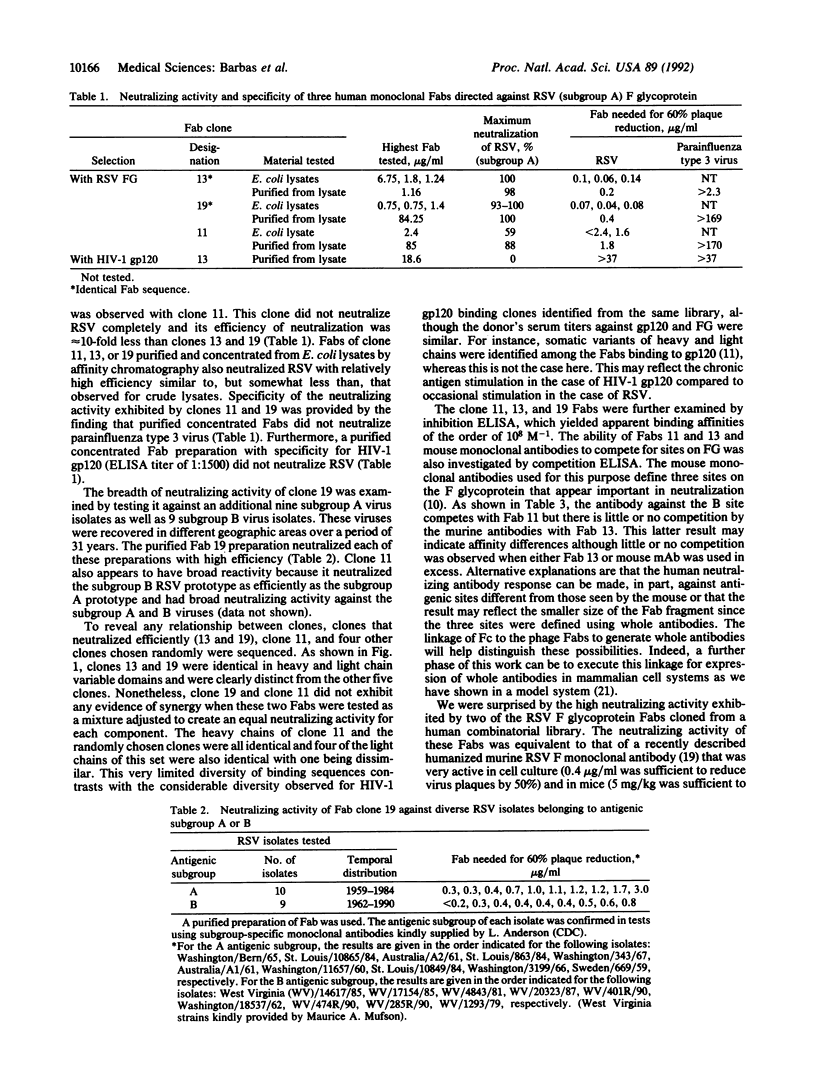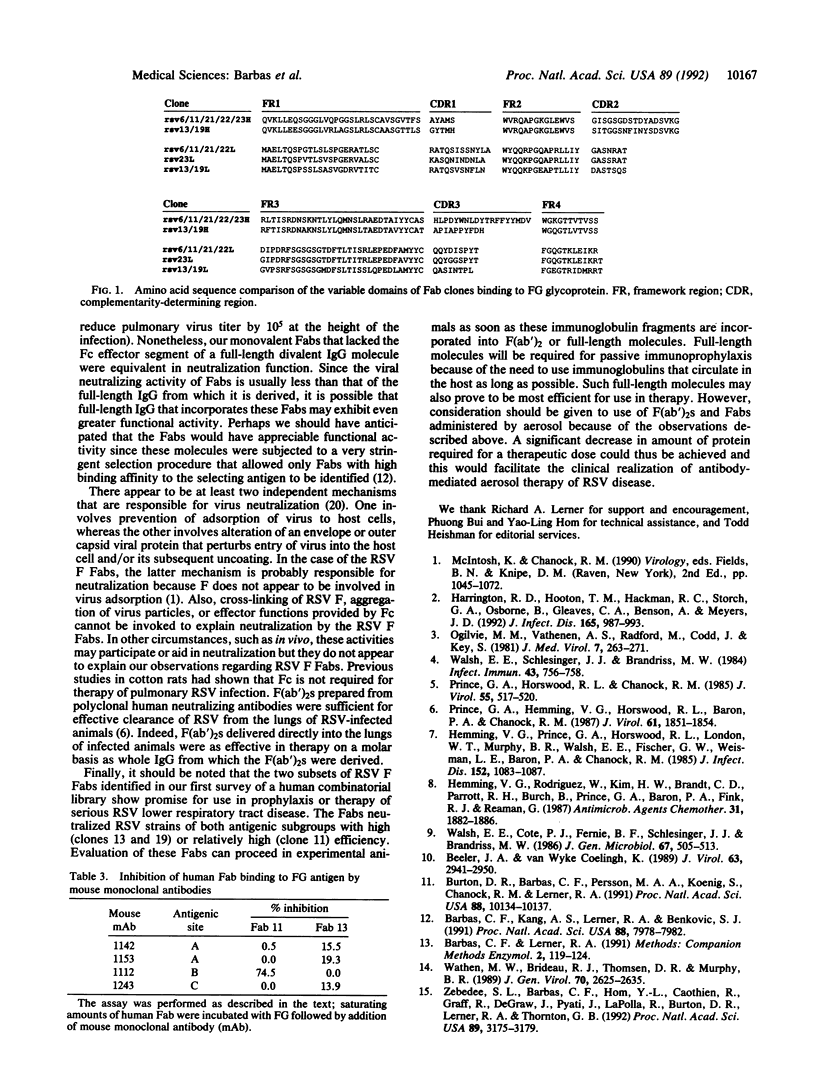Abstract
Respiratory syncytial virus (RSV) is the most important cause, throughout the world, of severe viral lower respiratory tract illness in young children. Antibodies are known to mediate resistance to RSV infection and illness. We have isolated a number of human monoclonal Fab fragments to RSV F glycoprotein from a combinatorial antibody library expressed on the surface of phage. One of these neutralized a wide range of virus isolates, 10 subgroup A and 9 subgroup B isolates, with a titer (60% neutralization) of approximately 0.1-1.0 micrograms/ml. Another Fab neutralized diverse isolates at a concentration somewhat higher. These human Fab fragments show great promise for use in the prophylaxis or therapy of serious RSV lower respiratory tract disease. For intramuscular or intravenous administration, whole antibodies will be required, whereas for aerosol application, F(ab')2 or Fab fragments may suffice.
Full text
PDF




Selected References
These references are in PubMed. This may not be the complete list of references from this article.
- Barbas C. F., 3rd, Kang A. S., Lerner R. A., Benkovic S. J. Assembly of combinatorial antibody libraries on phage surfaces: the gene III site. Proc Natl Acad Sci U S A. 1991 Sep 15;88(18):7978–7982. doi: 10.1073/pnas.88.18.7978. [DOI] [PMC free article] [PubMed] [Google Scholar]
- Beeler J. A., van Wyke Coelingh K. Neutralization epitopes of the F glycoprotein of respiratory syncytial virus: effect of mutation upon fusion function. J Virol. 1989 Jul;63(7):2941–2950. doi: 10.1128/jvi.63.7.2941-2950.1989. [DOI] [PMC free article] [PubMed] [Google Scholar]
- Burton D. R., Barbas C. F., 3rd, Persson M. A., Koenig S., Chanock R. M., Lerner R. A. A large array of human monoclonal antibodies to type 1 human immunodeficiency virus from combinatorial libraries of asymptomatic seropositive individuals. Proc Natl Acad Sci U S A. 1991 Nov 15;88(22):10134–10137. doi: 10.1073/pnas.88.22.10134. [DOI] [PMC free article] [PubMed] [Google Scholar]
- Coates H. V., Alling D. W., Chanock R. M. An antigenic analysis of respiratory syncytial virus isolates by a plaque reduction neutralization test. Am J Epidemiol. 1966 Mar;83(2):299–313. doi: 10.1093/oxfordjournals.aje.a120586. [DOI] [PubMed] [Google Scholar]
- Harrington R. D., Hooton T. M., Hackman R. C., Storch G. A., Osborne B., Gleaves C. A., Benson A., Meyers J. D. An outbreak of respiratory syncytial virus in a bone marrow transplant center. J Infect Dis. 1992 Jun;165(6):987–993. doi: 10.1093/infdis/165.6.987. [DOI] [PubMed] [Google Scholar]
- Hemming V. G., Prince G. A., Horswood R. L., London W. J., Murphy B. R., Walsh E. E., Fischer G. W., Weisman L. E., Baron P. A., Chanock R. M. Studies of passive immunotherapy for infections of respiratory syncytial virus in the respiratory tract of a primate model. J Infect Dis. 1985 Nov;152(5):1083–1087. doi: 10.1093/infdis/152.5.1083. [DOI] [PubMed] [Google Scholar]
- Hemming V. G., Rodriguez W., Kim H. W., Brandt C. D., Parrott R. H., Burch B., Prince G. A., Baron P. A., Fink R. J., Reaman G. Intravenous immunoglobulin treatment of respiratory syncytial virus infections in infants and young children. Antimicrob Agents Chemother. 1987 Dec;31(12):1882–1886. doi: 10.1128/aac.31.12.1882. [DOI] [PMC free article] [PubMed] [Google Scholar]
- Ogilvie M. M., Vathenen A. S., Radford M., Codd J., Key S. Maternal antibody and respiratory syncytial virus infection in infancy. J Med Virol. 1981;7(4):263–271. doi: 10.1002/jmv.1890070403. [DOI] [PubMed] [Google Scholar]
- Persson M. A., Caothien R. H., Burton D. R. Generation of diverse high-affinity human monoclonal antibodies by repertoire cloning. Proc Natl Acad Sci U S A. 1991 Mar 15;88(6):2432–2436. doi: 10.1073/pnas.88.6.2432. [DOI] [PMC free article] [PubMed] [Google Scholar]
- Prince G. A., Hemming V. G., Horswood R. L., Baron P. A., Chanock R. M. Effectiveness of topically administered neutralizing antibodies in experimental immunotherapy of respiratory syncytial virus infection in cotton rats. J Virol. 1987 Jun;61(6):1851–1854. doi: 10.1128/jvi.61.6.1851-1854.1987. [DOI] [PMC free article] [PubMed] [Google Scholar]
- Prince G. A., Horswood R. L., Chanock R. M. Quantitative aspects of passive immunity to respiratory syncytial virus infection in infant cotton rats. J Virol. 1985 Sep;55(3):517–520. doi: 10.1128/jvi.55.3.517-520.1985. [DOI] [PMC free article] [PubMed] [Google Scholar]
- Tempest P. R., Bremner P., Lambert M., Taylor G., Furze J. M., Carr F. J., Harris W. J. Reshaping a human monoclonal antibody to inhibit human respiratory syncytial virus infection in vivo. Biotechnology (N Y) 1991 Mar;9(3):266–271. doi: 10.1038/nbt0391-266. [DOI] [PubMed] [Google Scholar]
- Walsh E. E., Cote P. J., Fernie B. F., Schlesinger J. J., Brandriss M. W. Analysis of the respiratory syncytial virus fusion protein using monoclonal and polyclonal antibodies. J Gen Virol. 1986 Mar;67(Pt 3):505–513. doi: 10.1099/0022-1317-67-3-505. [DOI] [PubMed] [Google Scholar]
- Walsh E. E., Schlesinger J. J., Brandriss M. W. Protection from respiratory syncytial virus infection in cotton rats by passive transfer of monoclonal antibodies. Infect Immun. 1984 Feb;43(2):756–758. doi: 10.1128/iai.43.2.756-758.1984. [DOI] [PMC free article] [PubMed] [Google Scholar]
- Wathen M. W., Brideau R. J., Thomsen D. R., Murphy B. R. Characterization of a novel human respiratory syncytial virus chimeric FG glycoprotein expressed using a baculovirus vector. J Gen Virol. 1989 Oct;70(Pt 10):2625–2635. doi: 10.1099/0022-1317-70-10-2625. [DOI] [PubMed] [Google Scholar]
- Zebedee S. L., Barbas C. F., 3rd, Hom Y. L., Caothien R. H., Graff R., DeGraw J., Pyati J., LaPolla R., Burton D. R., Lerner R. A. Human combinatorial antibody libraries to hepatitis B surface antigen. Proc Natl Acad Sci U S A. 1992 Apr 15;89(8):3175–3179. doi: 10.1073/pnas.89.8.3175. [DOI] [PMC free article] [PubMed] [Google Scholar]


